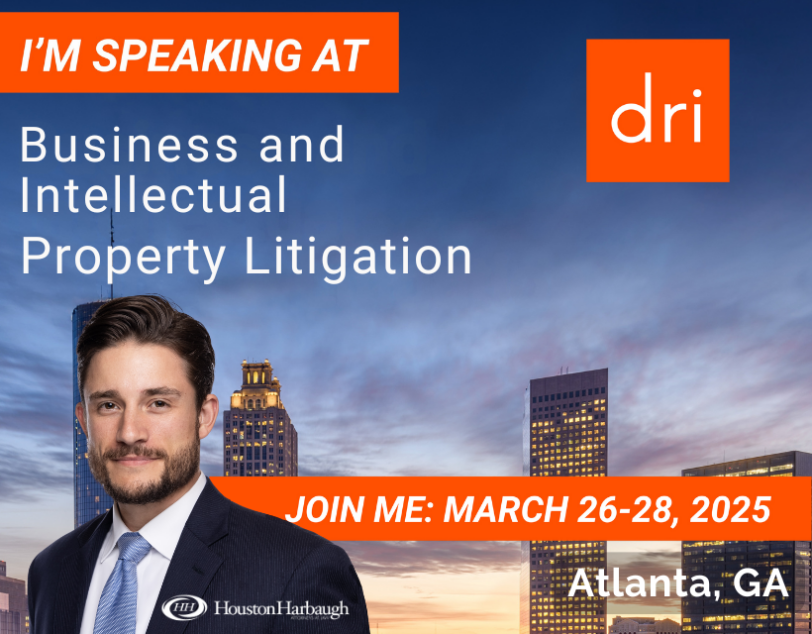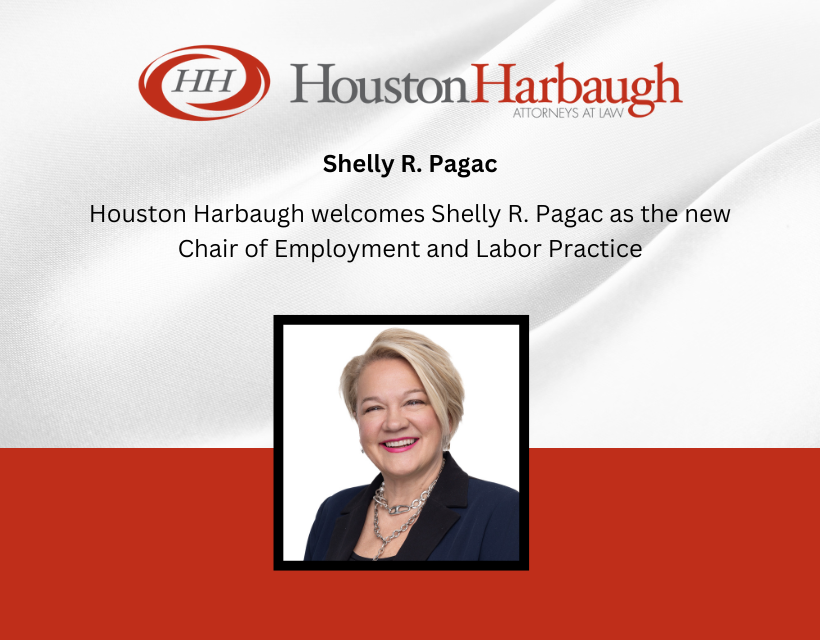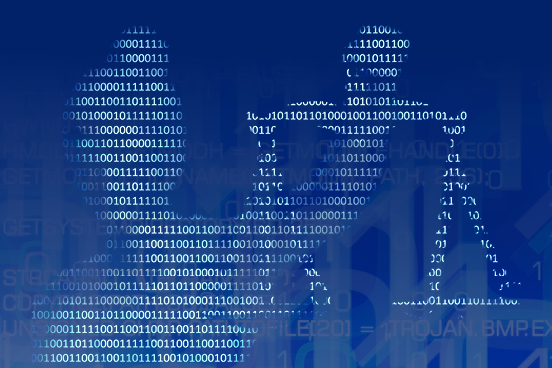PA Federal Business Decisions Volume 16, No. 2
Third Circuit Affirms $23 Million Dollar Award in Indirect Copyright Infringement Case
In William A. Graham Co. v. Haughey, No. 10-2762, 2011 U.S. App. LEXIS 9906 (3d Cir. May 16, 2011), the court was asked to review the propriety of a jury verdict for Plaintiff which totaled nearly $19 million and a corresponding award of more than $4.6 million in prejudgment interest in a copyright infringement action.
In 1991, Defendant Haughey (“Haughey”) left the employment of Plaintiff William A. Graham Co. (“Graham”), an insurance brokerage, and accepted a position with a competitor, USI Mid-atlantic, Inc. (“USI”). Haughey took with him two binders from Graham which had been prepared by Graham’s employees and were subject to Graham’s copyrights. The binders contained hundreds of pages of text which described insurance coverage types, exclusions, conditions, and other information pertinent to the insurance brokerage business.
From July 1992 through 2005, Haughey and USI (“Defendants”) used the binders to prepare insurance coverage proposals to present to their clients. This constituted an “indirect” infringement in that Haughey and USI used copyrighted materials, without permission, to sell their own insurance products, as opposed to “direct” infringement which involves reproducing and selling others protected works without permission. In 2004, Graham became aware of Defendants’ practices. Shortly thereafter, Graham filed suit against (“Defendants”) under the Copyright Act, 17 U.S.C. §§ 101 et seq. Defendants initially asserted that the case failed under the three year statute of limitations. However, the district court held that the discovery rule applied and concluded that the jury should determine when Graham should have known of the violations.
Under the Copyright Act, a plaintiff is permitted to recover either statutory damages or “actual damages and any additional profits of the infringer.” 17 U.S.C. § 504(a). However, Graham eschewed the statutory damages provision and did not assert that it had suffered any actual damages. Consequently, Graham was only able to recover the profits attributable to Defendants’ infringement. To succeed on such a claim, a plaintiff must prove defendants’ gross revenue over the course of the pertinent time period and then establish a causal nexus between the infringement and the profits sought.
At trial, Graham proved gross commissions of roughly $32 million for USI and $3 million for Haughey personally. The jury also found causation. The burden then shifted to Defendants to prove that some of their revenues were attributable to factors other than copyrighted work, which would render those profits not subject to recovery.
Graham conceded that 25 percent of USI’s revenues were deductible expenses and that Graham’s total recovery could be only about $24 million. Defendants then asserted that their own efforts had contributed to their successes and that Graham’s recovery had to be reduced accordingly. The jury agreed in part, and it awarded Graham roughly $16.5 million from USI and $2.3 million from Haughey.
With respect to the discovery rule, the jury found that Graham had not been on notice of the infringement until February 2002, thereby preserving all of Graham’s claim. However, the district court set aside this portion of the jury’s verdict, ruling that Graham had been placed on “inquiry notice” as of the fall of 1991 through “storm warnings.” The district court conducted a second trial limited to the damages that had arisen within three years of the commencement of Graham’s action. The jury awarded a total verdict of $2.668 million. The parties then cross-appealed.
Graham argued that the district court’s “storm warning” analysis was improper, and Defendants asserted that Graham had failed to prove the requisite causal nexus. On appeal, the Third Circuit reversed the district court’s finding of “storm warnings” in light of the first jury’s well-supported conclusion that Graham could not have known of the infringement until February 2002. The Third Circuit also affirmed that the required causal nexus had been established at the first trial. The Third Circuit then remanded the case to the district court to consider whether the jury’s apportionment of Defendants’ profits was supported by the evidence and therefore, whether the verdict was excessive.
On remand, the district court rejected Defendants’ excessiveness argument and reinstated the original jury’s verdict. It also granted Graham’s motion for prejudgment interest, in the amount of $4,112,859 against USI and $570,542 against Haughey, both of which it awarded in accordance with Graham’s uncontested, expert’s calculations. The district court rejected Defendants’ argument that prejudgment interest is not recoverable in a copyright action for infringers’ profits. The court also rejected Defendants’ argument that prejudgment interest began to accumulate in 2004, as opposed to 1992, the date used by Graham’s expert.
Defendants again appealed to the Third Circuit. Defendants asserted that the jury’s verdict was so excessive as to shock the judicial conscience. Defendants argued for a reduction in the verdict in light of profits that were realized based on factors other than the copyrighted work. Defendants emphasized the various tasks and relationship building involved in any sale and asserted that those efforts accounted for more than the 25 to 30 percent of earnings attributed by the jury. Graham countered by pointing to evidence that the copyrighted materials were an important element in Defendants’ overall sales strategy. Moreover, Defendants had used the materials in over 850 sales proposals to 315 different clients over the course of thirteen years. Defendants also willfully destroyed materials relevant to the case after being ordered by the trial court to preserve them, which thereby entitled Graham to a spoliation instruction. In light of the conflicting evidence and the steep burden on appeal, the Third Circuit concluded that the verdict did not shock the judicial conscience and affirmed.
Second, Defendants argued that an award of prejudgment interest was improper under the Copyright Act and that it should not be granted in cases involving an infringer’s profits. The court rejected each of these arguments. It found that although the Copyright Act is silent on whether prejudgment interest is recoverable, the Congressional silence in the Act favored permitting such an award because district courts ordinarily have broad discretion to award prejudgment interest on judgments obtained pursuant to federal statutes. Moreover, an award of prejudgment interest was consistent with the purposes of the Copyright Act, making the claimant whole and preventing unjust enrichment. Denying prejudgment interest to a successful plaintiff would serve as a windfall to the defendant in the form of an interest-free loan. The court also found that prejudgment interest is recoverable in infriger’s profits actions because disgorgement was an objective of the Copyright Act. As such, the court held that “prejudgment interest is available in copyright cases at the district court’s discretion,” which should be exercised consistent with “considerations of fairness.”
Finally, Defendants maintained that interest should not have begun to accumulate until Graham discovered the infringement in 2004, rather than the date on which the infringement began in 1992. According to Defendants, under the discovery rule, a claim does not accrue until discovered by a plaintiff, and the Supreme Court has observed that prejudgment interest “serves to compensate for the loss of use of money due as damages from the time the claim accrues until judgment is entered.” However, the Third Circuit held that accrual “occurs at the moment at which each of its component elements has come into being as a matter of objective reality, such that an attorney with all of the facts could get it past a motion to dismiss for failure to state a claim.” Although the distinction had been poorly recognized previously, the discovery rule merely serves to toll the statute of limitations; it has no impact on accrual for purposes of calculating prejudgment interest. Thus, the district court’s calculation was appropriate. Additionally, the court observed that prejudgment interest is designed to achieve full compensation for a plaintiff’s injury, which must include the full period beginning at the time of injury. Applied under these circumstances, full disgorgement had to be awarded from the date that Defendants received their first illicit profit.
Court Grants Motion for Attorney Fees of Prevailing Defendant Under Lanham Act
In Allegheny Coupling Co. v. Betts Indus., Inc., No. 06-76, 2011 U.S. Dist. LEXIS 34721 (W.D. Pa. Mar. 31, 2011) (opinion by J. McLaughlin), after the court granted summary judgment in favor of Defendant Betts Industries, Inc. (“Betts”) as to Plaintiff Allegheny Coupling Co.’s (“Allegheny”) trademark infringement claim, Betts filed a Motion for Attorney Fees and Costs Pursuant to 15 U.S.C. §1117(a)(3). The court held that this was the rare “exceptional” case that supported an award of attorney fees under the statute and granted Betts’ motion.
Allegheny markets and sells industrial couplings and fittings. Betts manufactures products for the highway cargo tank industry. On March 24, 2006, Allegheny commenced an action against Betts alleging, inter alia, trademark and trade dress infringement in violation of the Lanham Trademark Act, 15 U.S.C. §1051 et seq. (Lanham Act). In the Third Amended Complaint, Allegheny asserted a claim for trade dress infringement relative to Allegheny’s “coupling and fitting products,” claiming that such products had size, shape, color and texture characteristics which constituted a valid and protectable trade dress configuration and that its trade dress was “nonfunctional and distinctive.” In the Third Amended Complaint, Allegheny also asserted a claim for trademark infringement with respect to the phrases “Allegheny Coupling,” “Allegheny Coupling Co.” and “Allegheny & Design.”
Throughout discovery, Betts sought clarification as to which specific products formed the basis for Allegheny’s trademark and trade dress infringement claims. Initially, Allegheny identified 2,267 products. After the court directed Allegheny to delineate specifically and with sufficient detail which of those 2,267 products formed the basis for the trademark and trade dress infringement claims, Allegheny responded by producing a list containing 2,110 products. During discovery, however, Allegheny failed to identify trade dress features for many of the thousands of products that it claimed were subject to trade dress protection.
On March 9, 2009, counsel for Betts sent a letter to Allegheny requesting that Allegheny withdraw its trade dress claim. Allegheny refused. Thereafter, Betts filed a motion for summary judgment which raised the same deficiencies in Allegheny’s trade dress claim that counsel for Betts had identified in the March 9, 2009 letter. Allegheny responded to Betts’ summary judgment motion by withdrawing the trade dress infringement claim without explanation. Prior to the withdrawal of the trade dress infringement claim, Betts had spent over one hundred hours responding to discovery requests regarding the extensive list of items over which Allegheny asserted trade dress infringement.
In relation to the trademark infringement claim regarding the Allegheny phrases, Betts requested documents in discovery relating to Allegheny’s efforts to register alleged trademarks with the United States Patent and Trademark Office (USPTO). In response to these requests, Allegheny produced its “trademark file,” which included documents reflecting USPTO approval of certain marks on the Supplemental Register. However, Allegheny omitted various documents showing that Allegheny’s applications for registration on the Principal Register had been rejected by the USPTO on the basis of the geographical descriptiveness of the Allegheny marks. The court found that Allegheny’s failure to turn over the omitted documents was purposeful, rather than inadvertent. On March 18, 2010, the court granted summary judgment in favor of Betts as to Allegheny’s trademark infringement claim on the basis that Allegheny’s asserted trademarks were primarily geographically descriptive. Thus, they were only subject to protection upon proof that they had acquired secondary meaning, which Allegheny failed to prove.
Betts next filed its motion for attorney fees and costs. Section 35(a) of the Lanham Act, 15 U.S.C. §1117(a)(3) provides that “the court in exceptional cases may award reasonable attorney fees to the prevailing party.” In determining whether Betts’ motion for attorney fees and costs should be granted, the court considered whether Allegheny engaged in culpable conduct and whether the circumstances were “exceptional” enough to warrant a fee award.
The court found that Allegheny’s filing and continued pursuit of its trade dress claim was patently frivolous and groundless. The court also found that the serving of voluminous discovery on Betts by Allegheny regarding the hundreds of products over which it asserted trade dress protection represented the type of oppressive and harassing conduct that lends further support to an attorney fee award. Finally, the court found that Allegheny’s intentional failure to produce documents relative to its attempted registration of phrases with the USPTO was further evidence of the abusive conduct engaged in by Allegheny.
The court held that these facts displayed culpable conduct and made this “the rare ‘exceptional’ case which supports an award of attorney fees.” Accordingly, the court granted Betts’ motion for attorney fees and costs. The court ordered that a hearing would be set at a later date to determine the amount of the attorney fee award.
– Contributed by R. Brandon McCullough, Esq., Houston Harbaugh, Pittsburgh, Pennsylvania; bmccullough@psmn.com
Patentee Awarded Lost Profits as Damages in Patent Infringement Suit
In Air Vent, Inc. v. Vent Right Corporation, No. 2:08-cv-00146, 2011 U.S. Dist. LEXIS 36328 (W.D. Pa. Apr. 4, 2011) (opinion by J. McVerry), Plaintiff Air Vent (“Air Vent”) filed an action against Defendant Vent Right (“Vent Right”) asserting, inter alia, that Vent Right’s Breasevent product was a “knock-off” copy of one of Air Vent’s products, Shinglevent® II. After the close of discovery, the court granted summary judgment in favor of Air Vent on infringement and denied summary judgment on Vent Right’s claim of invalidity. Subsequently, the court granted leave for counsel for Vent Right to withdraw as counsel as a result of Vent Right’s failure to pay outstanding legal fees and costs. Vent Right never retained new counsel, and after Air Vent’s motion for default judgment went unopposed, the court granted the motion and held a hearing on Air Vent’s claim for damages.
Air Vent based its damage claim on the theory of lost profits, and specifically, asserted that but for the sale of infringing products by Vent Right, Air Vent would have otherwise made such sales and would have realized the incremental profits from such sales. Title 35 U.S.C. § 284 provides that an award for a claimant shall be adequate to compensate for the infringement, “but in no event less than a reasonable royalty for the use made of the invention by the infringer, together with interest and costs as fixed by the court.” According to the court, the phrase “damages adequate to compensate” means full compensation for any damages suffered as a result of the infringement, which includes any foreseeable lost profits the patentee can prove.
A patentee who claims lost profits must show: (a) a demand for the patented products; (b) an absence of acceptable non-infringing substitutes; (c) a capacity to exploit the demand in the absence of the infringing products; and (d) the amount of profit the patentee would have made. The court noted that the patentee must satisfy its initial burden of showing a reasonable probability that it would have made the asserted sales but for the infringement, and then the burden shifts to the accused infringer to show that the patentee’s but for causation claim is unreasonable for some or all of the lost sales. Also, according to the court, absolute certainty in calculating lost profits is not required; it must be shown with reasonably certainty that the additional sales would have been made in the absence of the infringing product. Based on the undisputed record evidence and on an expert report submitted on behalf of Air Vent, the court found that Air Vent satisfied each prong necessary to establish its entitlement to lost profits and awarded such damages accordingly.
In addition to claiming lost profits, Air Vent also made a claim for treble damages pursuant to 35 U.S.C. § 284. The court noted that this finding of increased damages is punitive in nature and based on the conduct and culpability of the infringer. Specifically, the Court of Appeals for the Federal Circuit has held that an award of enhanced damages requires a showing of willful infringement. Furthermore, the Federal Circuit has set forth factors, i.e. the Read factors, for district courts to consider when determining whether damages should be enhanced. These factors are: (1) whether the infringer deliberately copied the ideas or design of another; (2) whether the infringer, when he knew of the other’s patent protection, investigated the scope of the patent and formed a good-faith belief that the patent was invalid or not infringed; (3) the infringer’s behavior as a party to the litigation; (4) the infringer’s size and financial condition; (5) closeness of the case; (6) duration of the infringer’s misconduct; (7) remedial action by the infringer; (8) the infringer’s motivation for harm; and (9) whether the infringer attempted to conceal its misconduct. Based on the default judgment and the Read factors, Air Vent clearly satisfied its burden in this case, and the court ruled that an award of enhanced damages was appropriate and reasonable.
With respect to prejudgment interest, the court concluded that Air Vent was unable to provide any justification for the award of prejudgment interest in its post hearing filings. However, the court did award post judgment interest pursuant to 28 U.S.C. § 1961, which mandates that interest should be allowed on any money judgment in a civil case recovered in a district court.
Finally, with respect to attorneys’ fees, the court cited 35 U.S.C. § 285, which provides for an award of reasonable attorney fees to the prevailing party in exceptional patent infringement cases, and undertook the two-step process in determining whether to award fees. The court analyzed whether Air Vent proved by clear and convincing evidence that the case was exceptional and whether an award of attorneys’ fees was appropriate. Based on the record evidence, the court concluded that Vent Right acted willfully in infringing Air Vent’s product, and its actions rose to the level of exceptional.
– Contributed by Esq., Houston Harbaugh, Pittsburgh, Pennsylvania;
Court Rejects Rule 9(b) Challenge to False Marking Case
In United States of America ex rel. FLFMC, LLC v. Williams Bounds, Ltd., No. 10-0420, 2011 U.S. Dist. LEXIS 24554 (W.D. Pa. Mar. 11, 2011) (opinion by J. Lancaster), the court denied Defendant’s motion to dismiss for failure to plead fraudulent intent under Federal Rule of Civil Procedure 9(b).
Defendant Bounds (“Bounds”) made pepper mills which were allegedly marked with a patent that expired in 1983. In addition, Bounds advertised the pepper mills with reference to the expired patent. Plaintiff FLFMC (“FLFMC”) brought suit, alleging that Bounds falsely marked these products with an expired patent in violation of 35 U.S.C. § 292(b). Bounds moved to dismiss, arguing that FLFMC failed to plead that Bounds intended to deceive the public with the specificity required under Rule 9(b).
The court agreed that Rule 9(b) applies to false marking claims but noted that the Third Circuit applies a looser standard when the information relating to the fraudulent conduct is exclusively in the defendant’s control. Under this relaxed standard, plaintiffs must still support their allegations with statements of facts. According to the court, FLFMC met this standard.
FLFMC alleged that Bounds was a sophisticated company with decades of experience with patents. Bounds employed experienced patent counsel to manage its patent portfolio and knew that its patents had a limited lifetime. Finally, FLFMC argued that it was plainly unreasonable to mark products with a patent that had been expired for over twenty years. Taken together, these allegations were sufficient to meet the Rule 9(b) pleading requirements regarding Bounds’ intent to deceive the public. The court, therefore, denied Bounds’ motion to dismiss under Rule 9(b).
Infringement Injunction Indicates Lengthy Litigation Approaching Adjournment
Arlington Industries (“Arlington”) and Bridgeport Fittings (“Bridgeport”) are direct competitors in the electrical conduit fittings market. Their decade-long battle over whether Bridgeport has been infringing Arlington patents recently came one step closer to conclusion. Judge Conner of the Middle District lifted a stay on a permanent injunction against Bridgeport in Arlington Industries, Inc. v. Bridgeport Fittings, Inc., No. 01-0485, 2011 U.S. Dist. LEXIS 16492 (M.D. Pa. Feb. 18, 2011).
In the years prior to this recent decision, Arlington and Bridgeport both filed lawsuits alleging that Bridgeport had or had not infringed on Arlington’s patents. As a result, at one point there were two separate lawsuits before two different Middle District judges, both of whom were asked to determine whether Bridgeport’s “Whipper-Snap” fitting violated Arlington’s ‘050 patent. Judge Caputo ruled that it did not; Judge Conner let the matter proceed to a jury, which ruled that it did. Given this division, Judge Conner granted but stayed an injunction against Bridgeport pending an appeal.
On appeal, a divided Federal Circuit panel ruled 2-1 in favor of Arlington. Arlington then asked Judge Conner to lift the stay. Bridgeport opposed that request and argued that it had asked the Federal Circuit to alter its decision or to hear the matter again en banc. Bridgeport suggested that these outcomes were likely given the nature of the case and the amount of publicity it had obtained among patent lawyers.
Judge Conner was thus in the unique position of having to determine how the traditional factors for granting an injunction, including a party’s likelihood of success on the merits, would apply to an appeal that was not before him. He determined that the proper approach would be to apply the four traditional factors to the facts that he had. He then ordered that the stay be lifted after concluding that: 1) Bridgeport was unlikely to prevail on further appeal, as en banc hearings are generally unlikely; 2) Bridgeport had already had the benefit of a stay for some time and would not be irreparably injured if it ended now; 3) given the length of the proceedings to date, Arlington would suffer substantial injury if the injunction were further delayed; and 4) the public interest in the enforcement of patents suggested that the injunction should at long last be imposed.
Accordingly, Judge Conner determined that: 1) the traditional factors that govern the issuance of an injunction apply even to injunctions pending an appeal; and 2) on the facts in this matter, those factors weighed in favor of Arlington’s request that an injunction be lifted.
– Contributed by Jason Spak, Esq., Houston Harbaugh, Pittsburgh, Pennsylvania; jspak@psmn.com
Summary Judgment Inappropriate Where Abandonment of Mark Not Strictly Proven
In Brown & Brown, Inc. v. Cola, No. 10-3898, 2011 U.S. Dist. LEXIS 31147 (E.D. Pa. Mar. 23, 2011) (opinion by J. Buckwalter), Defendants Robert Cola and Ryan Tola (“Defendants”) sought summary judgment against Plaintiff Brown & Brown, Inc. (“Brown”). Defendants argued that Brown had abandoned the name of Doyle Consulting Group, and therefore, Brown’s claims relating to Lanham Act violations could not succeed. The court, however, concluded that genuine issues of fact existed on this matter and ultimately denied summary judgment.
In 2004, Brown executed an asset purchase agreement with Doyle Consulting Group, Inc. (“DCG”), an insurance brokerage business, to acquire DCG’s business. DCG was owned by Frank Doyle (“Doyle”) and Kevin Mullin (“Mullin”). The agreement provided that Doyle, Mullin and DCG would cease using the corporate name of “Doyle Consulting” and any other trademarks or trade names in business dealings. Brown continued to use the name “Doyle Consulting” as a service mark in its business. Defendants were previously employed by DCG and continued their employment following Brown’s acquisition of DCG. Brown required Defendants to sign new employment agreements. In 2006 and 2007, Brown began using the “Brown & Brown Consulting” name and made efforts to eliminate the use of “Doyle Consulting Group.” In 2010, Doyle formed a new insurance brokerage firm, Doyle Alliance Group, which became Brown’s competitor. Defendants eventually joined Doyle Alliance Group and allegedly solicited Brown’s customers and employees in violation of their employment agreements.
Brown alleged Lanham Act violations against Defendants based on unfair competition under section 43(a), 15 U.S.C. § 1125, and trademark infringement under section 32, 15 U.S.C. § 1114. Defendants countered that Brown had abandoned the Doyle Consulting name. Defendants argued that: (1) Brown did not use the mark; and (2) there was an intent to abandon. Under this abandonment theory, Defendants had to show “complete cessation or discontinuance of trademark usage” by Brown. If Brown could show even one instance of the mark’s use, the assertion of abandonment would be defeated. The court noted that “to prove bona fide usage, the proponent of the trademark must demonstrate that use of the mark has been deliberate and continuous, not sporadic, casual or transitory.”
Additionally, to succeed on their defense of abandonment, Defendants had to demonstrate an actual intent to abandon, not simply acts showing abandonment. The court also recognized that “abandonment under § 1227 requires an intent not to resume trademark use, as opposed to a prospective intent to abandon the mark in the future” and that “a prospective declaration of intent to cease use in the future, made during a period of legitimate trademark use, does not meet the intent not to resume standard.”
Abandonment of a trademark must be strictly proven and the burden lies with the party who claims abandonment. The Lanham Act, 15 U.S.C. § 1127, further provides that nonuse of a mark for three consecutive years is “prima facie evidence of abandonment.” The burden of production then shifts to plaintiff to show “evidence that it either used the mark during the statutory period or intended to resume use.” Because the issue of abandonment is typically a factual question, the court held that “while intent to resume ‘may be inferred from circumstances,’. . . summary judgment is ‘notoriously inappropriate for determination of claims in which issues of intent, good faith and other subjective feelings play dominant roles.”
Defendants argued that in 2006, the transition from using the Doyle Consulting name to Brown & Brown had been successful with the Doyle Consulting name being removed from Brown’s advertising, correspondence, business cards and other communications. Brown, however, asserted that it had continued to use the Doyle name in presentations, promotions and advertisements, citing specific examples of use through 2011. The court determined that the record reflected conflicting evidence, and therefore, Defendants failed to strictly prove abandonment as required by the Third Circuit. Thus, summary judgment was barred.
– Esq., Houston Harbaugh, Pittsburgh, Pennsylvania; kdempsey@psmn.com
Court Dismisses False Marking Claim Where Marks Appeared in Manuals and Not on Products
In Hollander v. Timex Group USA, Inc., No. 10-429, 2011 U.S. Dist. LEXIS 39962 (E.D. Pa. Apr. 13, 2011) (opinion by J. Schiller), a patent false marking case, the court granted Defendant’s motion for summary judgment, finding that Plaintiff Hollander (“Hollander”) failed to offer any evidence that Defendant Timex (“Timex”) marked an unpatented article or intended to deceive the public.
Hollander noticed that some of the hard and electronic manuals for some of Timex’s wristwatches contained references to expired Timex patents. In addition, Hollander found references to these expired patents in the “Terms of Use” section of Timex’s website. Believing that this constituted false patent marking under 35 U.S.C. § 292(b), Hollander brought suit.
The evidence showed that when Timex prepared new product manuals, a production designer typically “cut and pasted” boilerplate text from prior manuals. This process resulted in some expired patent numbers being included in newer product manuals. The court found that no one from Timex directed that these expired patent numbers be included; rather they were inadvertently carried over from prior work. The manuals were included in the box with the wristwatches, and electronic versions were available on Timex’s website in a “Product Instruction Guides & Downloads” section.
To be liable for false marking, a plaintiff must prove that a defendant (1) falsely marked an unpatented article (2) with the intent to deceive the public. The court determined that Hollander failed to establish either element.
As to the first element, the court found that the expired patent numbers had to be on the product itself, as opposed to its instruction manual or a website in order to potentially state a claim for false marking. While the manuals were included with the wristwatches, they were not affixed to them.
The court also rejected Hollander’s argument that the patent numbers in the manuals or on the website amounted to using false marks in advertising. The court drew a distinction between manuals, which are used to instruct the user on how to operate the wristwatches, and advertising, which is designed to call public attention to a product. It did not matter that the manuals were publicly available, because they were not readily visible to the public or designed to call the public’s attention to the products. Similarly, the court found that the “Terms of Use” section of the website was not advertising within the meaning of § 292(b).
As the court stated, “the statute is not intended to create a treasure hunt for relators scouring department store shelves or corporate websites for obscure references to expired patents; it prohibits readily visible marks-on products themselves, affixed to products, or used in advertising in connection with products-falsely indicating that an unpatented article enjoys patent protection.”
As to the second element, the court found that even if the wristwatches were falsely marked, there was no intent to deceive the public. The court held that a plaintiff cannot rely on concepts of agency and collective corporate knowledge to show the required scienter. Hollander had no evidence that anyone at Timex realized that the patents found in these manuals had expired. At most, the evidence showed that Timex was careless in creating these manuals, which was not sufficient to find liability under the statute.







